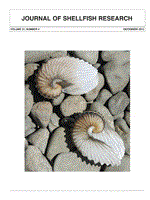Mussels (Mytilus spp.) are used frequently in biological effects studies and biomonitoring programs either as transplanted groups or native populations. However, as a result of the similarities in the external morphology of Mytilus, which are influenced by environmental factors, visual identification is often never certain. Because differences in contaminant bioaccumulation and biomarker responses may occur among the 3 mussel species Mytilus edulis, Mytilus trossulus, and Mytilus galloprovincialis, bias in biological effects studies and biomonitoring programs is likely. In the current study, mussels were collected from strategic locations along the 25,000-km Norwegian coastline and identified to species by polymerase chain reaction amplification of gill tissue DNA. Specific primers were used to amplify the Glu gene (polyphenolic adhesive protein), which has been validated previously to identify the different Mytilus species. The amplified products were electrophoresed, showing specific bands for M. edulis (180 bp), M. trossulus (168 bp), and M. galloprovincialis (126 bp), with the presence of 2 bands suggesting Mytilus hybrids. The results identified the presence of all 3 Mytilus species in a patchy distribution around the Norwegian coast, with the Mediterranean species M. galloprovincialis located up to 60°N. The implications of this situation for biomonitoring programs and exposure studies are discussed.
How to translate text using browser tools
1 August 2013
The Distribution of the Mussel Mytilus Species Along the Norwegian Coast
Steven J. Brooks,
Eivind Farmen
ACCESS THE FULL ARTICLE

Journal of Shellfish Research
Vol. 32 • No. 2
August 2013
Vol. 32 • No. 2
August 2013
DNA amplification
hybrids
monitoring
mussels
Mytilus edulis
Mytilus galloprovincialis
Mytilus trossulus




